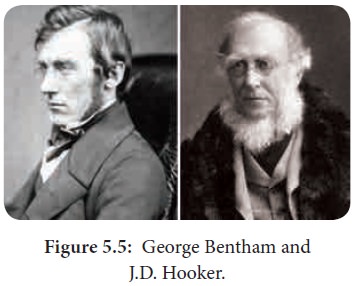Chapter: 11th Botany : Chapter 5 : Taxonomy and Systematic Botany
Bentham and Hooker (Natural) system of classification
Natural system
Botanists who came after Linnaeus realised that no
single character is more important than the other characters. Accordingly an
approach to a natural system of classification sprouted in France. The first
scheme of classification based on overall similarities was presented by Antoine Laurent de Jessieu in 1789.
Bentham and Hooker system of classification

A widely followed natural system of classification
considered the best was proposed by two English botanist George Bentham (1800 - 1884) and Joseph Dalton Hooker (1817–1911). The classification was published in a three volume work as “Genera Plantarum” (1862–1883) describing
202 families and 7569 genera and 97, 205 species. In this system the seeded
plants were classified into 3 major classes such as Dicotyledonae, Gymnospermae
and Monocotyledonae.
Class I
Dicotyledonae: Plants contain
two cotyledons in their seed, leaves with reticulate venation, tap root
system and tetramerous or pentamerous flowers come under this class. It
includes three sub-classes – Polypetalae,
Gamopetalae and Monochlamydeae.
Sub-class
1. Polypetalae:
Plants with free petals and
dichlamydeous flowers come under polypetalae. It is further divided into three
series – Thalamiflorae, Disciflorae and Calyciflorae.

Series
(i) Thalamiflorae: Plants having
flowers with dome or conical shaped thalamus and superior ovary are included in
this series. It includes 6 orders and 34 families.
Series
(ii) Disciflorae: Flowers having
prominent disc shaped thalamus with superior ovary come under this series.
It includes 4 orders and 23 families.
Series
(iii) Calyciflorae: It includes plants having flowers with cup shaped thalamus and with inferior or
sometimes with half inferior ovary. Calyciflorae includes 5 orders and 27
families.
Sub-class
2. Gamopetalae: Plants with united
petals, which are either partially or completely fused to one another and
dichlamydeous are placed under Gamopetalae. It is further divided into three
series – Inferae, Heteromerae and Bicarpellatae.
Series
(i) Inferae: The flowers are
epigynous and with inferior ovary. Inferae includes 3 orders and 9
families.
Series
(ii) Heteromerae: The flowers are
hypogynous, superior ovary and with more than two carpels. Heteromerae includes
3 orders and 12 families.
Series
(iii) Bicarpellatae: The flowers are
hypogynous, superior ovary and with two carpels.Bicarpellatae includes 4 orders
and 24 families.
Sub-class
3. Monochlamydeae: Plants with incomplete flowers either apetalous or with undifferenciated calyx and corolla are placed under Monochlamydeae. The sepals and petals are not
distinguished and they are called perianth.
Sometimes both the whorls are absent. Monochlamydeae includes 8 series and 36
families.
Class II
Gymnospermae: Plants that contain
naked seeds come under this class. Gymnospermae includes three families –
Gnetaceae, Coniferae and Cycadaceae.
Class III
Monocotyledonae: Plants contain
only one cotyledon in their seed, leaves with parallel venation, fibrous root
system and trimerous flowers come under this class. The Monocotyledonae has 7
series and 34 families.
The Bentham and Hooker system of classification is
still supposed to be the best system of classification. It has been widely
practiced in colonial countries and herbaria of those countries were organised
based on this system and is still used as a key for the identification of
plants in some herbaria of the world due to the following reasons:
·
Description of plants is quite accurate and
reliable, because it is mainly based on personal studies from actual specimens
and not mere comparisons of known facts.
![]()
![]()
![]()
•
As it is easy to follow, it is used as a key for
the identification of plants in several herbaria of the world.
Though it is a natural system, this system was not
intended to be phylogenetic.
Related Topics